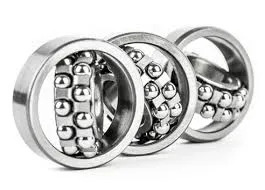
Oct . 14, 2024 08:26 Back to list
Understanding the Functionality of Bearing Taper Sleeves in Mechanical Applications
Understanding Bearing Taper Sleeves An Essential Component in Mechanical Systems
In the world of mechanical engineering, precision and reliability are paramount, especially when it comes to rotating machinery. One crucial component that plays a significant role in the effective functioning of various machines is the bearing taper sleeve. This article explores what bearing taper sleeves are, their design, function, and applications, as well as their importance in ensuring the smooth operation of mechanical systems.
What is a Bearing Taper Sleeve?
A bearing taper sleeve is a cylindrical piece that features a tapered external profile designed to fit snugly within the interior of a bearing housing or onto a shaft. This component serves as a connecting interface between the bearing and other components in machinery. By facilitating a secure and stable fit, bearing taper sleeves help maintain the alignment and positioning of bearings, which in turn supports efficient rotary motion.
Design and Structure
The design of a bearing taper sleeve typically includes a series of intricate dimensions that correspond to both the bearing and the components it connects to. The tapering allows for a gradual and controlled fitting, ensuring that there is minimal slippage or play once installed. This is especially important because any misalignment can lead to increased wear, noise, and potential failure of the bearings themselves.
Bearing taper sleeves can be made from various materials, including steel, bronze, and other alloys, depending on their specific application requirements. The choice of material directly affects their durability, load capacity, and resistance to corrosion, making it crucial to select the right type for any given situation.
Functionality
The primary function of bearing taper sleeves is to facilitate the mounting of bearings onto shafts. By using a taper sleeve, engineers can achieve a tighter interference fit, which is essential for handling the radial and axial loads exerted on bearings during operation. This tight fit not only reduces the risk of movement between the bearing and shaft but also minimizes vibrations that can lead to more serious mechanical issues.
bearing taper sleeve

Furthermore, taper sleeves allow for easier disassembly and maintenance of mechanical systems. Their design means that components can be quickly removed or replaced without causing damage to adjacent parts. This feature is particularly valuable in industrial settings where downtime must be minimized and maintenance efficiency is critical.
Applications
Bearing taper sleeves are widely used in a variety of industries, including manufacturing, automotive, aerospace, and construction. They are integral to machinery where rotary motion is involved, such as electric motors, pumps, gearboxes, and conveyors. In the automotive sector, taper sleeves are used in applications that require precise wheel alignment and stability. In manufacturing, they can be found in assembly lines where machinery operates at high speeds and under tremendous loads.
Importance in Mechanical Systems
The significance of bearing taper sleeves cannot be overstated; they play a fundamental role in ensuring the reliability and longevity of machinery. A properly fitted taper sleeve contributes to the overall efficiency of a mechanical system, as it helps reduce friction and wear. Moreover, given the harsh environments in which many industrial machines operate, using high-quality taper sleeves can prevent premature failure and costly repairs.
Regular inspection and maintenance of bearing taper sleeves are also vital. Any signs of wear or degradation should be addressed immediately to prevent compound failures that could compromise the integrity of the entire system. Engineers and technicians must ensure that they are installed correctly and that the specifications are adhered to for optimal performance.
Conclusion
Bearing taper sleeves may be small components, but their impact on the functionality and reliability of mechanical systems is significant. From enhancing load capacity to facilitating ease of maintenance, they are essential in a myriad of applications across various industries. Understanding their design, function, and importance will empower engineers and technicians to optimize their use, thereby improving the efficiency and reliability of the machinery they support. As technology advances and new materials are developed, the future of bearing taper sleeves looks promising, paving the way for even more durable and efficient machines.
Latest news
-
Grooved Ball Bearing Design and Functionality
NewsJun.04,2025
-
Concrete Mixer Bearing Load Capacity Testing
NewsJun.04,2025
-
6004 Bearing Dimensions in Robotic Joint Designs
NewsJun.04,2025
-
Advantages of Single-Row Deep Groove Ball Bearings
NewsJun.04,2025
-
Applications of Deep Groove Ball Bearings in Automotive Systems
NewsJun.04,2025
-
Innovations in Bearing Pressing Machine Design
NewsJun.04,2025
